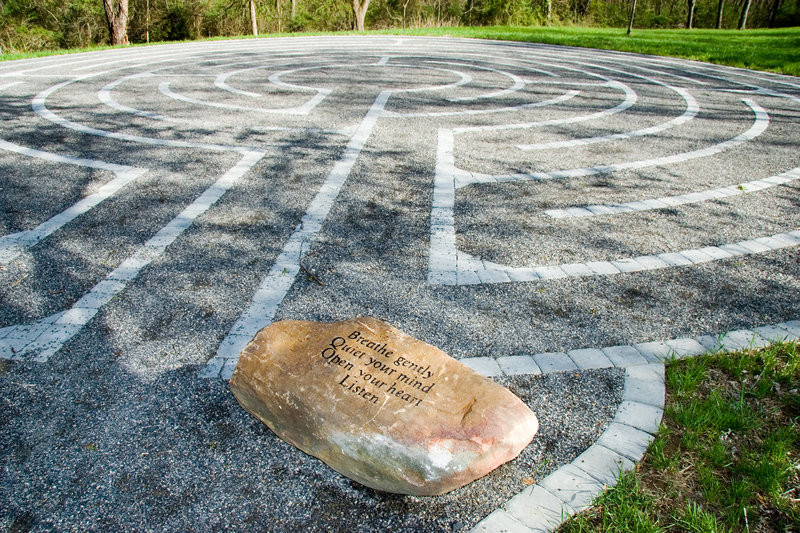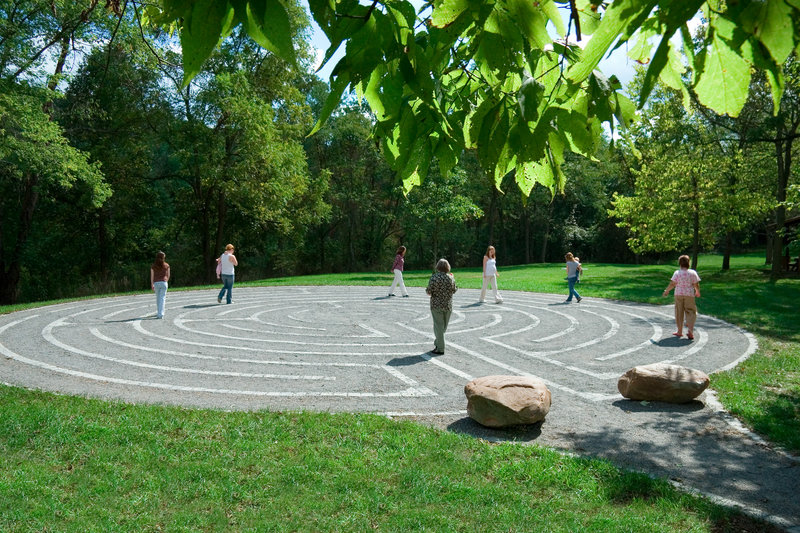When Carol Maurer has a lot on her plate, she finds it useful to visit the labyrinth made of river rocks at the Delaware Art Museum, in Wilmington.
“It quiets my mind,” said Maurer, who lives in Hockessin, Del. “It sets the path for me so I can spiral inward.”
Labyrinths, which have been constructed for thousands of years, have become a popular addition to hospitals, gardens and public institutions.
With a single path in and out, labyrinths are designed to encourage reflection. They differ from mazes, which are designed as puzzles. Labyrinths have been associated with religions and cultures throughout the world.
The number of labyrinths in the United States has been steadily increasing for about 15 years, said Robert Ferre, a labyrinth builder who founded Labyrinth Enterprises.
“Nowadays they’re so widespread, it’s more about how to best utilize them than what they are,” he said from San Antonio, Texas.
When he started the business in 1995, churches were his primary customers. Labyrinths were an important feature of European Roman Catholic churches in the Middle Ages; walking one was a devotional activity and represented a spiritual journey.
The most famous remaining labyrinth from that period is at Chartres Cathedral, near Paris. Many newer labyrinths are based on the Chartres pattern.
They can be constructed of turf or stone or painted on pavement.
Today, labyrinths are widely used in secular spaces too, said Maurer, who serves on the board of The Labyrinth Society, an organization dedicated to using and promoting the paths. She helped get the labyrinth built near the sculpture garden at the Delaware Art Museum.
“People are looking for ways to travel inward,” she said. “They’re trying to find a deeper connection with themselves that may be spiritual but not necessarily religious.”
It’s even possible for homeowners to build labyrinths themselves in their yard, with rock, gravel or mulch, Ferre said. Plans are available online or through his company.
Patricia Cadle, the oncology chaplain at N.C. Cancer Hospital in Chapel Hill, N.C., encourages patients, family members and hospital employees to walk a labyrinth.
The medical facility dedicated an outdoor labyrinth in 2009, and just completed an indoor one this month (February).
“It’s a great tool for meditation and relaxation,” Cadle said.
“Labyrinths can help connect the mind, the body and the spirit. I think we can use that when we’re dealing with disease.”
Allegany College of Maryland in Cumberland built a labyrinth in 2005 as part of its integrative health program, which focuses on holistic approaches to healing. The walking path has become widely used on campus, said Cherie Snyder, a professor and director with the program.
“Many of the faculty here have incorporated it into their teaching,” she said.
The community, initially unsure of the labyrinth, also has put it to good use, she said.
“A lot of times people think it’s a religious cult,” she said. But once area residents understood the labyrinth’s history, they began to visit. Cancer support groups, church groups and organizations that serve the developmentally disabled have all used the labyrinth, Snyder said.
“It’s just been a wonderful tool to introduce people to walking meditation, walking prayer and communing with nature,” she said.
Many users feel a labyrinth inspires creativity, said Katja Marquart, a member of The Labyrinth Society and an associate professor of interior architecture at the University of Wisconsin-Stevens Point. She has encouraged graduate students to walk a labyrinth to help them sort out their work.
“They always came back with really great insights,” she said.
Copy the Story Link
Send questions/comments to the editors.




Success. Please wait for the page to reload. If the page does not reload within 5 seconds, please refresh the page.
Enter your email and password to access comments.
Hi, to comment on stories you must . This profile is in addition to your subscription and website login.
Already have a commenting profile? .
Invalid username/password.
Please check your email to confirm and complete your registration.
Only subscribers are eligible to post comments. Please subscribe or login first for digital access. Here’s why.
Use the form below to reset your password. When you've submitted your account email, we will send an email with a reset code.